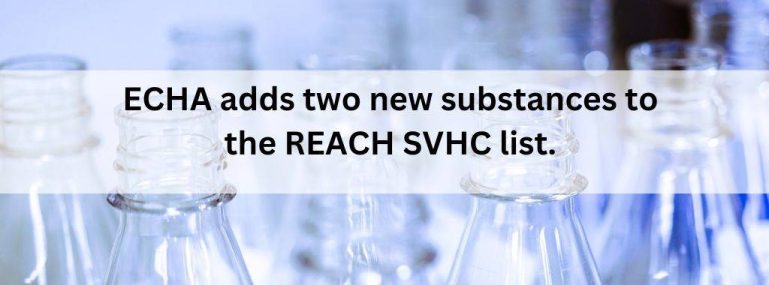The European Chemicals Agency (ECHA) has updated the Candidate List of substances of very high concern, which now includes 235 hazardous chemicals. The new chemicals have been added to the REACH SVHC Candidate List to ensure a high level of protection for the environment and the health of humans when it comes to hazardous chemicals, as part of an effort to ensure a high level of protection.
It should be noted that one of the chemicals added is toxic for reproduction, whereas the other has persistent and bio accumulative properties. These chemicals are used in various products such as inks, toners, plastic production, and manufacturing processes. Organizations are responsible for managing the risks associated with these chemicals and providing information to customers and consumers about their safe use.
Below are the chemicals that are added to the REACH SVHC list.
| S.No | Substance name | EC number | CAS number | Reason for inclusion | Examples of use |
| 1 | Diphenyl (2,4,6-trimethyl benzoyl) phosphine oxide | 278-355-8 | 75980-60-8 | Toxic for reproduction (Article 57c) | Inks and toners, coating products, photo-chemicals, polymers, adhesives and sealants and fillers, putties, plasters, modeling clay. |
| 2 | Bis(4-chlorophenyl) sulphone | 201-247-9 | 80-07-9 | vPvB (Article 57e) |
Manufacture of chemicals, plastic products, and rubber products. |
The addition of these hazardous chemicals to the Candidate List raises concerns about their potential negative impacts on human health and the environment. Lack of awareness about the presence and risks of these chemicals can lead to unsafe handling and use, posing risks to individuals and the ecosystem.
Companies must fulfill their legal obligations under REACH (Registration, Evaluation, Authorization, and Restriction of Chemicals) regulations when their substances are included in the Candidate List.
Suppliers of articles containing Candidate List substances must provide information to customers and consumers to ensure safe usage. In addition to providing a safety data sheet, suppliers of these articles above a concentration of 0.1 % (weight by weight) must inform their customers and consumers of how to safely use them.
Importers, producers, and suppliers of substances on the Candidate List have specific notification and reporting requirements to ECHA to track the presence and concentration of these chemicals.
If an article contains a substance on the Candidate List, importers and manufacturers must notify ECHA within six months. Notification and reporting requirements facilitate better monitoring and management of these chemicals, minimizing their negative impact on human health and the environment.
ECHA’s addition of two hazardous chemicals to the Candidate List highlights the ongoing effort to identify and regulate substances that can harm people and the environment. Stricter regulations and increased transparency regarding the presence of these chemicals in products contribute to safer handling and usage.
ComplianceXL helps organizations with REACH regulatory compliance services in assisting them to collect REACH information for their products. As part of our compliance data management strategy, we also assist our customers in maintaining their supplier certificates and declarations on a regular basis so that they remain up to date. Also, we will provide Maintenance services to our customers to maintain and validate the regulatory documents to make sure accurate those are up-to-date and accurate.
FAQ:
Q1. What is the Candidate List?
A. The Candidate List is a compilation of substances of very high concern identified by the European Chemicals Agency due to their potentially harmful effects on human health or the environment.
Q2. What are the benefits of the Candidate List?
A. The Candidate List raises awareness about hazardous chemicals, enabling better risk management, safer product usage, and informed consumer choices. It also promotes monitoring and control of these substances, reducing their negative impact.





